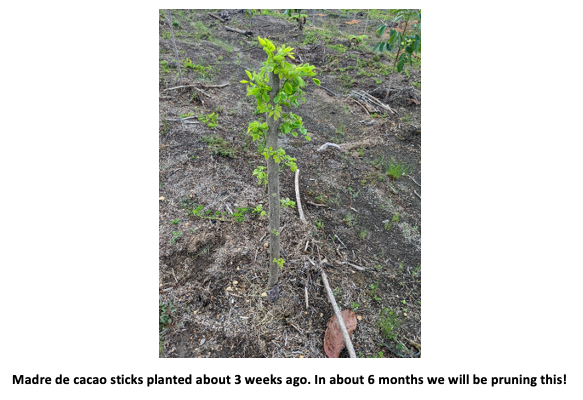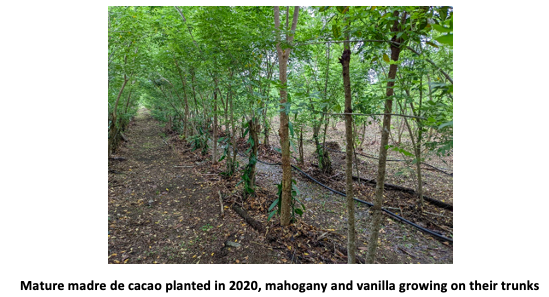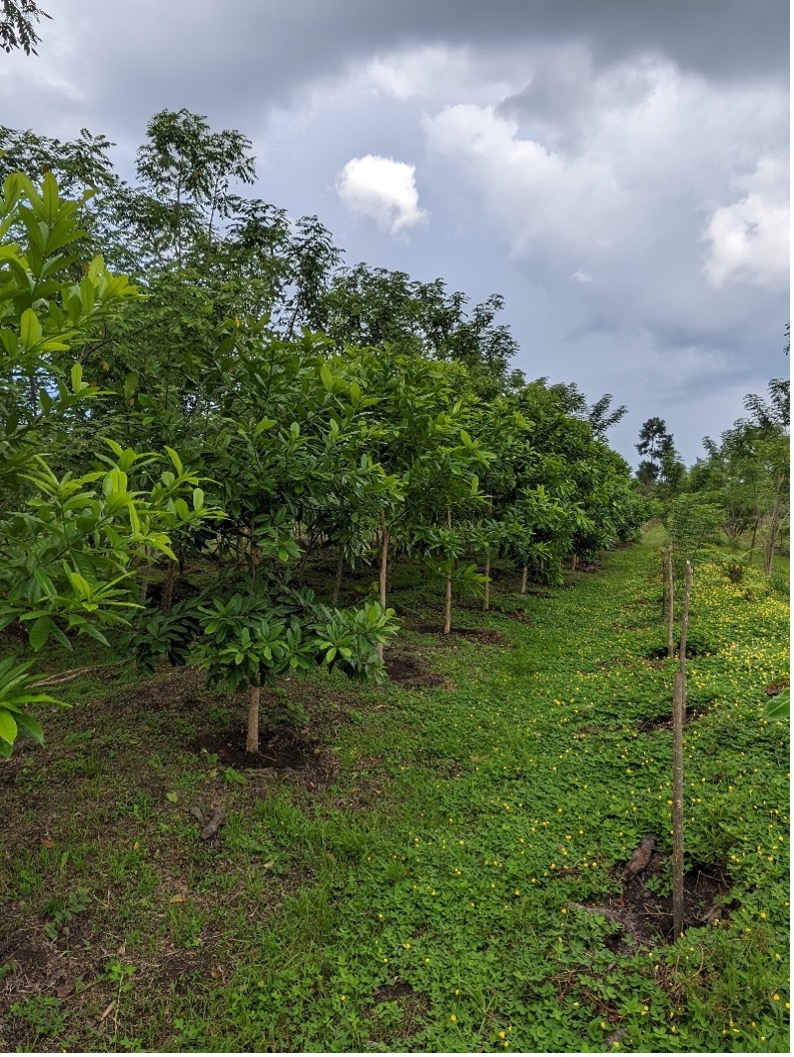Insight Focus
- Agroforestry helps carbon sequestration.
- Compost from pruning boosts cocoa, vanilla production.
- Aim is to show Belize farmers how to carry out agroforestry.
I was pleased to read last week that agroforestry was the third best thing to do to mitigate carbon after reducing deforestation and reforestation. I just hope we can keep all this carbon in the ground.
Since cocoa grows under shade and vanilla grows on shade, we are well underway planting more than 30,000 shade trees on our farm in Belize. At last count we have around 22 different plant species in our canopy. I’m just glad they can’t move around.
We use a mix of local Belizean hardwood – sandwood, yemeri, rosewood, San Juan plus mahogany, teak, moringa, inga, coconut and our workhorse, madre de cacao. It’s a fast-growing nitrogen fixing tree that’s also native to these parts. We prune it every few months and either use the larger branches as planting material, or it all goes into the chipper to make compost.

For a couple of years all we are going to be doing is producing compost! We put almost everything without a pulse into the chipper – old fruit and vegetables from a local fruit stand, cardboard, coconut husk, seaweed, pineapple crowns, stuff I find on the road on the way to the farm and grass clippings. Vanilla and cocoa love it.
Our planting combination was designed as a mix of different canopy heights, leaf drop (madre de cacao drops its leaves in the dry season exposing vanilla to the sun), planting density and honestly, availability of planting material. There just isn’t a nursery around the corner you can go to for these plants. While we know the local name for some of the trees (Billy Webb, prickle yellow anyone?) it’s hard to find any literature on how to cultivate them, so we rely on local experts and our field team for guidance.
Agroforestry Helps Pest Control
Our first plants went into the ground in 2017, and ever since the canopy has grown the farm has become markedly cooler. Its bought back more birds, including the famous toucan and hummingbirds, and this is starting to reduce insect damage, especially to our cocoa seedlings. We still have to deal with termites and a few caterpillars, but in my non-scientific but skin-in-the-game view having a mixture of trees seems to confuse these pests. They can’t smell a pure stand of cocoa so they don’t go looking for it.
We can also clearly see that having deep roots in the soil is also helping with drainage and the development of soil microbiota that can feed plants with nitrogen and phosphorus.

Another unintended consequence has been learning how to manage and prune all these different tree types. Some species grow better in combination with others. Some can handle poorly drained soils, some can’t. Moringa needs completely different pruning from madre de cacao, and it’s taken me hours of wandering around in the field with a machete to get the right pruning plan in place. With a monoculture you just start pruning or planting at one end of the field and keep going till it’s done. Not with agroforestry – there’s always something different to do each week.
We also use nitrogen fixing ground cover like peanut grass (Arachis pintoi) and pigeon pea. They also keep the weeds away and in the case of pigeon pea can shade our cocoa seedlings.
What Are We Trying to Do with Agroforestry?
The system tries to create a man-made approximation of a forest that can produce food and other products such as lumber and honey while contributing to carbon sequestration. One of our main goals is to demonstrate to local farmers how to do it, and to learn from our successes and mistakes. I know the pictures here don’t do it justice. Another is to preserve some of these rare and endangered hardwood species so we can produce seedlings, to create a research site for visiting scientists, and to support our vanilla as well as protect our cocoa trees.

We are still trying to find ways to measure how agroforestry helps mitigate climate change. I know in cocoa satellite imagery is commonly used to detect incursion of cocoa planting into protected areas in countries such as Ivory Coast and Ghana, but I’m not sure how they can measure the effectiveness of growing over 20 species at different heights in a particular area.
Carbon Sequestration Metrics Needed
It can be bewildering figuring out what to do because the field of measuring carbon sequestration and soil carbon is changing so rapidly. Right now, I’m stumped. So, we got started planting and are confident that an easy to use, defensible measurement system will be figured out soon, after all my LinkedIn feed is full of news about successful ag-tech seed rounds for things like this. I’m sure when cars were invented nobody stopped progress because they couldn’t work out how to calculate fuel efficiency.
I’m guessing that right now there are hundreds, if not thousands of farmers like me trying to figure this out reading literature, watching videos, visiting farms, googling stuff and — very rarely — attending conferences. In most cocoa and vanilla growing countries there’s no Department of Agriculture that can help with agroforestry because paradoxically, it’s so new, and so old.
What I’m saying is: Agroforestry works. I just can’t prove it right now.













